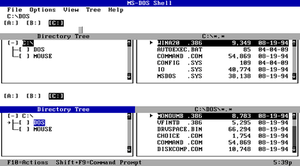DOS Shell
DOS Shell is a file manager, debuted in MS-DOS and IBM PC DOS version 4.0 (June 1988). It was discontinued in MS-DOS version 6.22, but remained part of the "Supplemental Disk". The Supplemental Disk could be ordered or could be downloaded through Microsoft's FTP server. DOS Shell was retained in PC DOS until PC DOS 2000.
 | |
| Developer(s) | Microsoft |
|---|---|
| Initial release | June 1988 |
| Operating system | MS-DOS and IBM PC DOS |
| Platform | x86 |
| Successor | File Manager, Windows Explorer |
| Type | File manager |
| License | Commercial software |
Overview
DOS Shell was one of the first successful attempts to create a basic graphical user interface (GUI) type file manager in DOS, although it is properly referred to as a text user interface (TUI) or Character-Oriented Windows (COW) even though graphical modes were available on supported hardware (VGA-equipped PCs). It was additionally one of the first GUIs developed by Microsoft, and later inspired the design of Windows. The shell is very much like a DOS version of File Manager found in Windows up to versions 3.11 and NT 3.51, and File Explorer on later versions.
In MS-DOS 4.x and 5.x the program was implemented as COM file (dosshell.com). In MS-DOS 6 the executable had an .EXE filename extension (dosshell.exe).[1]
Features
The shell includes common features seen in other file managers such as copying, moving and renaming files as well as the ability to launch applications with a double-click. The shell could be run by the command "DOSSHELL". It had the ability to set simple colours and styles.
The shell also has a help system, "program list", and a "task swapper". Like many modern file managers, it had the ability to display dual hierarchy directory and file lists, i.e. left and right panes, displaying both a list of directory contents and the hierarchical file path to the current working directory. The mouse was supported, however, like any other DOS application, it required an appropriate device driver.
One feature was the ability to list all files on a hard drive in a single alphabetized list along with the path and other attributes. This permitted the user to compare versions of a file in different directories by their attributes and easily spot duplicates.
Shortcomings
DOS Shell was incapable of full multitasking. It supported rudimentary task switching; it could switch between programs running in memory, at the cost of performance hit. However, all the running programs had to fit into conventional memory area, as there was no support for swapping to disk.
In time, Windows 3.1x, with its own graphical user interface, became much more popular among computer users. Windows was capable of multitasking. System performance was much higher, with complete access to extended memory.
See also
- ViewMAX – the equivalent component in DR DOS
- Comparison of file managers
- COMMAND.COM
References
Further reading
- Cooper, Jim (2001). Special Edition Using MS-DOS 6.22, Third Edition. Que Publishing. ISBN 978-0789725738.
- Wolverton, Van (1990). MS-DOS Commands: Microsoft Quick Reference, 4th Revised edition. Microsoft Press. ISBN 978-1556152894.